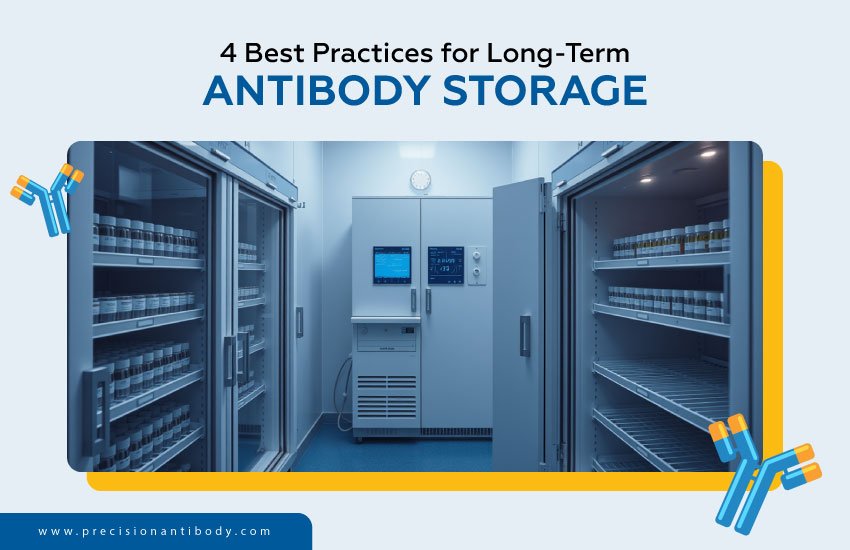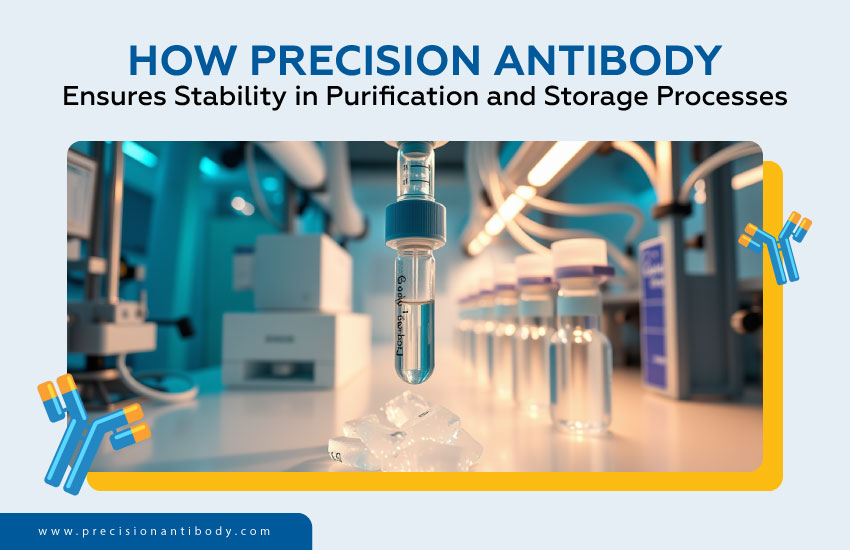Antibodies are strong but delicate tools used in diagnostics, therapeutics and research. Their complex structures can break down over time especially if stored in less-than-ideal conditions. Research indicates that monoclonal antibodies can still experience deamidation, oxidation and aggregation at 2–8°C which may lower their binding affinity and increase the risk of immunogenicity.
A study found that almost 30% of functional loss happened after six months because of bad storage practices. Aggregation is a big issue that can sneak up on you. It can cause immune responses or batch failures especially if antibodies are freeze-thawed too often or stored without the right stabilizers.
Stability issues are more than just a hassle; they can mess up clinical results, research trustworthiness and compliance with regulations. That’s why it’s super important to have stability in your storage strategy. Every detail counts from the right buffer systems and excipients to temperature control and lyophilization.
In this blog we’re going to explore some effective, science-backed strategies to help keep antibodies stable over time making sure your product performs when it really matters.

Antibody stability is key for the safety, effectiveness and consistency of biologics and diagnostic tools. Antibodies are big, complex proteins and they really don’t like changes in temperature, pH or mechanical stress like small molecules do. Even small instability can hurt performance over time, causing clinical setbacks, regulatory delays and unreliable results.
Therapeutic antibodies need to keep their structure and function from the time they’re made until they’re given to patients. Instability might cause:
Monoclonal antibodies kept in poor conditions lost more than 20% of their activity in just six months. Regulatory agencies such as the FDA, need a lot of stability testing data to approve shelf life claims for antibody based drugs.
Diagnostic assays (e.g. ELISA, flow cytometry, lateral flow tests) rely on antibodies to bind specific antigens.
However instability during storage can lead to:
Antibody degradation is a leading cause of diagnostic test variability especially in decentralized settings with limited cold chain storage.
Concisely, antibody stability isn’t just a technical detail; it’s a key quality factor. When you’re creating a life saving biologic or a high throughput diagnostic kit, stability is key. It makes sure your antibody works just right, from the first dose or test to the last.

Antibodies can become unstable due to their formulation and external factors, affecting their structure, function and shelf life. Antibodies are complex proteins influenced by temperature, pH, light and movement. Minor adjustments in storage can lead to denaturation, aggregation or chemical changes reducing the likelihood of binding and increasing the chance of triggering an immune response.
Studies demonstrate that not keeping these factors in check can speed up degradation, which affects the effectiveness of treatments, the reliability of diagnoses and compliance with laws. When antibodies are held for a long time these five things can impair their stability.
Temperature matters when it comes to keeping antibodies stable and functional. Most antibodies are kept at 2–8°C, but a few need to be frozen at –20°C or –80°C based on their formulation. However changes or prolonged exposure to high temperatures can cause irreversible denaturation and aggregation.
The pH of the formulation buffer can influence antibody solubility, charge interactions and chemical stability. An unsuitable pH may accelerate deamidation or promote aggregation especially near the antibody’s isoelectric point (pI).
Some antibodies are sensitive to light and can change structure when exposed to UV or regular light which can cause oxidation of aromatic residues and reduce their bioactivity.
Repeated freeze-thaw cycles can stress proteins causing them to unfold and clump together. This is a big issue in research and clinical labs where aliquots get accessed multiple times.
Microbial or endotoxin contamination harms antibodies and puts safety at risk in therapeutic uses. Even tiny contaminants can speed up hydrolysis or enzyme breakdown.
Antibody stability during storage relies on temperature, pH, light exposure, freeze-thaw cycles and contamination. If not managed properly it can lead to degradation, reduced binding or loss of function.

Antibodies should be stored properly for the long term to keep their structure and function intact. You can extend the shelf life and performance of antibodies by using the right storage temperature, buffer composition, handling techniques and keeping good records. There are four key best practices that can help keep antibody stability and ensure reliable results across different applications.
To store antibodies long-term you really need to pay attention to temperature, formulation and handling. Following best practices helps maintain stability, prevents issues and ensures everything runs smoothly over time.

It can be tricky to notice antibody degradation but even small changes can impact how they work and their reliability. Noticing early signs of instability lets researchers jump in fast, saving important samples or experiments. Instability usually appears as shifts in physical, chemical or functional features.
Here are the key indicators and tips for spotting them effectively:
Spotting these signs early prevents wasted materials, unreliable outcomes and failed batches ensuring consistent quality in research and therapy.

At Precision Antibody we focus on stability throughout our antibody development process. It’s a key part of our work, not just something extra. After we purify an antibody our team sticks to strict protocols to minimize degradation risks and keep it functional for the long term.
We use smart buffer systems, gentle purification methods and customized storage plans to suit each antibody’s unique structure and chemistry.
Precision Antibody gives you not only purity but also stability that lasts throughout time whether you’re getting ready for research tests or drug development.

Every antibody you make is a big investment of time, money and scientific potential. But if you don’t think about how to store an antibody it can lose its value even if it was made with the finest care. Bad buffer choices, wrong temperatures and frequent mistakes in handling can all slowly lower quality which can lead to inaccurate results or failed batches.
We don’t merely purify antibodies at Precision Antibody; we also keep their promise. We ensure your antibodies remain as strong on day 365 as they were on day one through smart storage methods, tailored stabilization strategies and careful handling after purification.
Don’t let instability sabotage your success.
Let Precision Antibody help you protect what matters: performance, reproducibility and results.
Explore our custom antibody services and ensure your investment pays off long term.
Depending on their formulation and sensitivity antibodies should be stored at –20°C or –80°C for a long time. Putting the samples into sterile, low binding tubes helps keep them from going through freeze-thaw cycles more than once.
Another good way to store things at ambient temperature is lyophilization which is sometimes known as freeze drying. This approach works well when moisture and light are kept under control.
Antibody stability can be enhanced by changing the buffer composition (pH 6.0–7.0) adding stabilizers such sugars (e.g. trehalose) or glycerol and reducing mechanical stress. For long term stability it’s also important to keep it from light, handle it in a clean way and store it at a constant temperature.
A common storage solution has a phosphate or citrate based buffer at pH 6–7 along with 0.01–0.05% sodium azide (to guard against microbes in research) and cryoprotectants such glycerol (10–50%) for freezing. The exact formulation should be different for each antibody type and use.

Led by innovative minds in immunology and the antibody development field, Precision Antibody has been an industry leader for over 20 years. We not only implement a cutting-edge technique in antigen design, antibody development, production, and other analyses, but we are also constantly working on ways to improve and advance technology to match the ever-changing world of science. If you are interested in learning more about Precision Antibody’s Custom Antibody development.
Precision Antibody™ is the forefront of the global Custom Antibody industry & it is led by the innovative minds in immunology and antibody development field.
